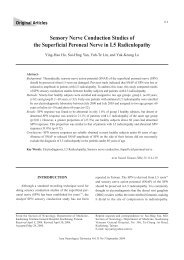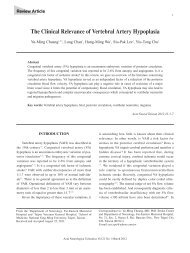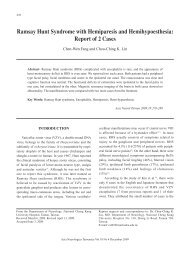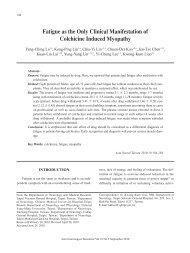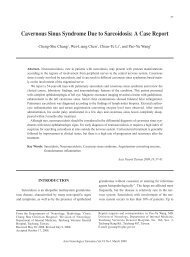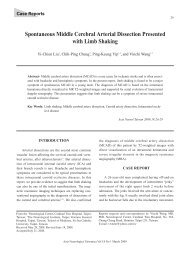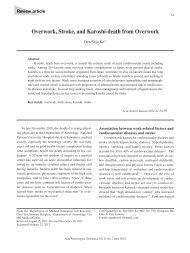Reverse Lhermitte's Phenomenon Provoked by ... - Vol.22 No.1
Reverse Lhermitte's Phenomenon Provoked by ... - Vol.22 No.1
Reverse Lhermitte's Phenomenon Provoked by ... - Vol.22 No.1
You also want an ePaper? Increase the reach of your titles
YUMPU automatically turns print PDFs into web optimized ePapers that Google loves.
36<br />
matic LP, which follows contusion of the spinal cord<br />
from neck trauma; (3) reverse LP, which is induced <strong>by</strong><br />
extrinsic compression of the cervical spinal cord during<br />
neck extension; (4) inverse LP, which is upward moving<br />
paresthesia induced <strong>by</strong> neck flexion (1) . Because reports of<br />
LP are limited in the Taiwan literature, we report this<br />
case.<br />
CASE REPORT<br />
A 74-year-old woman denied any systemic disease<br />
or history of trauma. She presented to our emergency<br />
department with sudden onset of right neck pain when<br />
extending the neck. The pain mimicked an electric shock<br />
and radiated to the left shoulder. Physical examination<br />
showed a rigid protrusion at the posterior part of the<br />
neck. The muscle power was grade 4 (Medical Research<br />
Council Scale) in the four limbs. Deep tendon reflexes in<br />
all four limbs were symmetrically normal. Both sides of<br />
her body, including the limbs and trunk, were sensitive<br />
to pain on a pinprick test (10/10). There was no neurological<br />
focal sign. Cervical radiographs revealed spondylosis<br />
and grade I anterolisthesis at the C3/4 and C4/5 levels<br />
when she flexed her neck (Fig. 1A, arrow head).<br />
After 30 mg ketoprofen was administrated intravenously,<br />
the strange phenomenon recurred until neck immobilization<br />
was recommended.<br />
She was transferred to our neurosurgical clinic<br />
where computed tomography showed a reversed lordotic<br />
curve of the cervical spine and grade I anterolisthesis at<br />
the C3/4 and C4/5 levels (Fig. 1 B&C, arrows).<br />
Magnetic resonance imaging demonstrated annular<br />
bulging at the 3rd ~ 7th intervertebral discs, causing<br />
mild thecal sac indentation (Fig. 2, dotted circle), but no<br />
spinal canal stenosis. A neck collar was recommended to<br />
immobilize her neck. Over the following year, the radiating<br />
neck pain did not recur, and the muscle power recovered<br />
to grade 5 in the four limbs.<br />
Figure 2. Magnetic resonance imaging, including a T1 fast spin echo<br />
sequence (TR/TE/excitation: 667/11.2/1), T2 fat relaxation<br />
fast spin echo sequence (TR/TE/excitation: 3100/100.7/1),<br />
and T2 fat saturation sequence (TR/TE/excitation:<br />
2933/116.4/1).<br />
DISCUSSION<br />
Figure 1. A: Cervical flexion and extension radiographs. B: Bone<br />
window (W 2,000, C 350) on sagittal computed tomography.<br />
C: Volume rendering on computed tomography.<br />
LP has been used as an eponym demonstrating<br />
ectopic sensory discharges from the mechanical stimulation<br />
of the abnormally excitable demyelinated central<br />
and peripheral sensory axons since 1932 (2) . It was experi-<br />
Acta Neurologica Taiwanica Vol 21 No 1 March 2012



